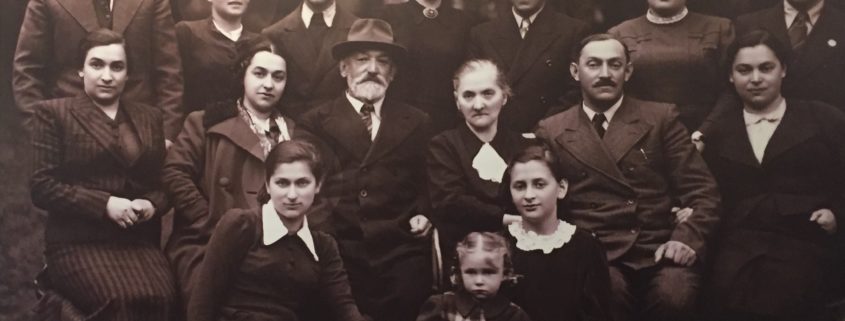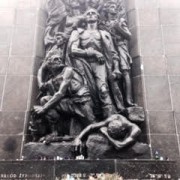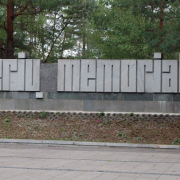Identity Challenges of Women in Resistance
By Lindsay Zerfas
Resistance to the Nazi regime took many different forms in occupied Europe. In many of these movements, women were a key part of resistance because they were less conspicuous, and therefore had greater chances of success in their activities. One of these women is Fania Brantsovsky. Through learning about Fania and her experience as a partisan fighter, we can explore the various ways war effects women who take up arms.
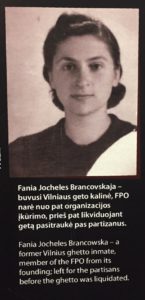 I had the incredible fortune of meeting Fania Brantsovsky in September 2016. At 94 she is still extremely active; she works 6 days a week and still exudes an energy I can only hope to have at her age. Fania was born in 1922 to a typical Jewish family in what is now Vilnius, Lithuania, but was Polish territory at the time of her birth. She lived with her family in the Vilnius Ghetto from the time it was built until the day it was liquidated; managing to escape just a few short hours before the rest of her family was deported and later killed in the Ponary Forest, a fact she did not know learn of until days later. The story behind Fania’s miraculous escape is fascinating, but what is especially interesting is the work done in her time with various partisan resistance groups.
I had the incredible fortune of meeting Fania Brantsovsky in September 2016. At 94 she is still extremely active; she works 6 days a week and still exudes an energy I can only hope to have at her age. Fania was born in 1922 to a typical Jewish family in what is now Vilnius, Lithuania, but was Polish territory at the time of her birth. She lived with her family in the Vilnius Ghetto from the time it was built until the day it was liquidated; managing to escape just a few short hours before the rest of her family was deported and later killed in the Ponary Forest, a fact she did not know learn of until days later. The story behind Fania’s miraculous escape is fascinating, but what is especially interesting is the work done in her time with various partisan resistance groups.
Before leaving the ghetto Fania was part of FPO, an underground resistance group in the Vilnius ghetto where she helped sneak in weapons piece by piece, trained to fight, and plotted resistance against the Nazi regime. After escaping the ghetto, she fought with the resistance group to “blast trains, blow up bridges and place explosives in enemy equipment.” Through this work, Fania was forced to transition from the traditionally feminine roles she held before the war: a scholar, a sister, a daughter, and a Jewish pre-school teacher into a trained partisan fighter. Nearly everyone she knew before the war was murdered and there was almost nothing left of Fania’s pre-war existence.
In the Vilnius ghetto and then as a partisan fighter, Fania sacrificed everything that being a ‘woman’ meant in the World War II era, giving up much of her identity that was central to her life before the war. After the war, Fania had no living family and no possessions from her life before the Nazi occupation. She had to rebuild a life with her new husband and cultivate a world in which to raise her daughters in the post-war Lithuania. Seventy years after the end of the war, Fania still struggles with the loss of her family and clings to items that represent her life in the few years following the end of the war.
What is key to her story is how she compartmentalized her pre-war experience, which is hidden behind a façade of social engagement as well has her private existence as a mother and wife. However, there are points where the two worlds intersect and Fania’s worlds fuse to make a new whole. During the research for her book Holocaust Legacy in Post-Soviet Lithuania, Shivaun Woolfson asks Fania to indicate two biographical objects important to understanding her past. The items Fania selected – a cloth flower brooch and a gold powder compact – were all items she received after the war was over. The brooch was a gift from her husband and former leader of the partisan group she fought with, Mikhail Brantsovsky. It was given to her after he had been abroad. The compact was a gift she received from a fellow partisan after the war, a man she had come to think of as a son. Both gifts were given to her by people she had met as a result of fighting in the partisan group and both were given to a woman who was formed in the war, born out of resistance fights.
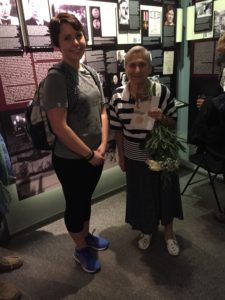 A woman who spent years fighting to “avenge their deaths.” The items she gave to Woolfson were “transitional objects,” or objects that, as psychotherapist D. W. Winnicot describes, are designated material objects for which special value is applied. Woolfson argues that, for Fania, these objects represent a journey from the death of World War II to life after the war. I argue that these objects represent a transition from life as a fighter to life as a civilian. They are the keepers of this fused identity, which rarely has had the opportunity to be put forth in her daily life in the post war era.
A woman who spent years fighting to “avenge their deaths.” The items she gave to Woolfson were “transitional objects,” or objects that, as psychotherapist D. W. Winnicot describes, are designated material objects for which special value is applied. Woolfson argues that, for Fania, these objects represent a journey from the death of World War II to life after the war. I argue that these objects represent a transition from life as a fighter to life as a civilian. They are the keepers of this fused identity, which rarely has had the opportunity to be put forth in her daily life in the post war era.
In her time fighting in partisan groups, Fania lived in the woods, even wearing old parachutes for clothing. Feminine objects were inaccessible and she was forced into behaviors and jobs that had previously been reserved for men. After the war, it seems to me that she desired some semblance of normalcy in her life; receiving feminine objects as a wife and semi-adoptive-mother would have been an excellent way of slipping into her role as a woman in the postwar Soviet Union.
Fania’s fight ends differently than the fights of many resistors in the war. She was fortunate enough to survive and, in many parts of Lithuania, is celebrated as a hero of the resistance and a Holocaust survivor. However, Fania’s struggles did not end with the war. Internally she still struggles with unimaginable losses and scars. For example, every year, she still silently remembers the birthdays of family members who were killed by the Nazis. Also, the way she raised her daughters was shaped by the war. She describes raising her two daughters as “‘hardworking and modest people just as we had been raised’ although they never . . . ‘took advantage of our position, never for example, owned a car.’” Postwar, she clung to items of femininity, so much so that they became representative of her life. It is as if after years of struggling in the war, having everything taken from her, and grappling with life in Soviet Lithuania, Fania’s identity had been challenged so greatly that she melded her identity with the desired identity of women in her time.
To add another layer of identity conflict, when Fania returned to Vilnius after the war, she found herself in the communist Lithuania that was now a part of the Soviet Union. It is important to note that it was the Soviets who first occupied Vilnius at the start of World War II; Vilnius fell under Soviet Territory in the Molotov-Ribbentrop pact. In this post war period, Fania joined the communist party and worked as a statistical analyst. Her husband held a high level post as a Chief of State Planning for Lithuania. While she was not in the security apparatus, she strove to build life of purpose, and did become a devoted citizen of the Soviet Union. In conversation with Woolfson, Fania states that she did not regret making contributions to the Soviet system through her daily life and work. Though she admits that later on she recognized the hypocrisy of the Soviets Union, at the time she had been one of it’s “true servants.” .
Fania faced numerous challenges in regards to her social role as a woman and her relationship with the Communist regime in the years after her life in the forest fighting alongside other partisans. The struggles during the war and after forced her to compartmentalize her experiences in most cases. However, through the examining of key moments in her life we can gain a deeper appreciation of the long-term affects of war and how life in the battlefield forces combat women to create new identities for themselves many years after the armed conflicts end.
1. Shivaun Woolfson, Holocaust Legacy in Post-Soviet Lithuania (London: Bloomsbury, 2014), 104.
2. Ibid.109.
3. ibid. 109.
4. Ibid, 98
5. Ibid. 97.
6. Shivaun Woolfson, Holocaust Legacy, 97, 111.
7. Ibid, 112.
8. Ibid, 107, 114.
9. Ibid, 108
10. ibid. 113.
11. Timothy Snyder, “Neglecting the Lithuanian Holocaust.” New York Review Blog (blog), July 25, 2011.
12. Woolfson, Holocaust Legacy, 113.

